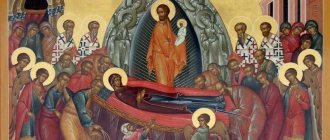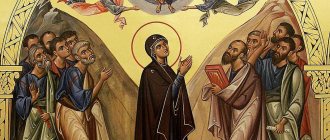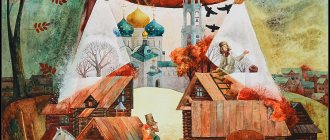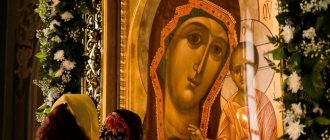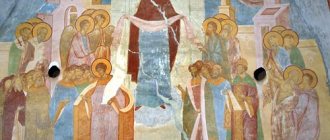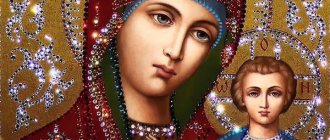Church traditions
From the words of Holy Scripture you can learn that the Mother of God, after the ascension of her son Jesus Christ to heaven, remained in the care of Saint John the Theologian.
Many church traditions explain the Dormition in different ways, what the resurrection of the soul is, and the emergence of the celebration of death. The customs and rules for celebrating the Dormition are poorly covered in the scriptures, as are all the main points of the end of the earthly journey of the Mother of God.
Also, from the entire sacred history of the New Testament, everyone knows how highly the Mother of the Lord was revered among the apostles when she was with them in Jerusalem.
Unfortunately, very few manuscripts from that time have reached us. Basically these creations were collected in the Holy Gospel and the New Testament.
Thanks to new archaeological devices, after numerous excavations in Jerusalem, the works of St. John the Evangelist were finally found.
These documents mention the life of the Mother of God, show her Dormition itself, what kind of event this was for the people and the whole history of that period.
This apocrypha (a secret written history that was not included in the canon of the Bible) says that after the massive persecution of King Herod Agrippa against the Church, the Mother of God, together with John the Theologian, moved for a while to the city of Ephesus.
When the persecution was stopped, the Mother of God, together with John, returned to Jerusalem, where she settled in his house on Mount Zion.
The history of the holiday
As the legend says, when one day the Mother of God went to the Mount of Olives to pray, she met the Archangel Gabriel there, in whose hands was a branch of a paradise palm tree. He preached to the Virgin Mary that three days later she would repose into Heaven, and the Lord would lift her, his own mother, into the Kingdom of Heaven, in which she would remain with him forever.
Upon returning to the house, the Mother of God told Saint John about her meeting with the Archangel Gabriel and her future death.
In her will, she asked to be buried in Gethsemane, next to her parents and her betrothed, the righteous Joseph.
In addition, the will indicated that two of her robes should be given to poor girls, who served her with great affection and hard work.
Presentation of the Virgin Mary to the Lord
The presentation of the Most Holy Theotokos itself was supposed to occur on the 15th day of August at the third hour of the day. At this time, candles were lit in the temple, and Mary lay on a beautiful decorated bed. In an instant, a sea of light flooded the Temple, in which Jesus Christ himself appeared with the angels, archangels and all the heavenly powers, and he approached the Virgin Mary.
Seeing the Son, the Most Holy Virgin joyfully spoke to him, and the Lord with trepidation and pride took her to Himself, and she, hearing his approval, gave her most pure soul to Her only Son.
According to church beliefs, after the death of the Mother of God, the apostles placed her body in a tomb and blocked the entrance to it with a large stone. Three days after his death, they were joined by the Apostle Thomas, who tearfully begged and begged for a chance to say goodbye to the Blessed Virgin Mary. At his request, the apostles rolled away the stone and entered the cave with it, but what was their surprise when they found only the Virgin’s robe, and she herself was not there, and a pleasant fresh smell of herbs came from the cave itself.
Dormition of the Blessed Virgin Mary in 2021, what does the word Dormition mean?
The words about the Most Holy Theotokos are clear, but what could the Dormition mean? This Old Slavonic word means a peaceful, calm death, that is, death. Therefore, the holiday date is colored with grief and sadness. Where does the joy of believers come from and why is it customary to congratulate each other? The transition of the Mother of God into the eternal Kingdom of Heaven and her reunification with her son Jesus and God are celebrated.
What date is the Dormition of the Blessed Virgin Mary celebrated in 2019? This holiday is one of the great ones and does not change the date. In Orthodoxy, believers will celebrate the passage of Our Lady into Heaven on August 28th. The Catholic Church will celebrate the Assumption on August 15.
On the night before the holiday, a service is held, prayers are read and a shroud is brought out, on which the Mother of God is depicted. The priests and believers walk around the church with the shroud. The all-night vigil ends with the anointing of those present with oil and solemn chants. In the morning, services are held in the church, during which the priests dress in blue clothes. He is a symbol of the purity and innocence of the Mother of God.
As the holy books say, after the execution of Jesus, the Apostle John took upon himself the care of Mary. She lived in his house and often went to the site of the ascension of Christ, the Mount of Olives. There, in solitary prayers, she spent almost all her days, asking the Lord to quickly take her soul from her earthly body. And the Archangel Gabriel appeared to the Most Pure Virgin. He told her the joyful news that three days remained before the end of her earthly journey; she would soon appear before the Heavenly Father. Gabriel handed Mary a branch of a date palm, shining with a wonderful light. The Archangel said that the branch would need to be carried in front of the coffin of the Blessed Virgin during the funeral procession.
The Mother of God rejoiced and hurried home, where she showed the shining branch to her family, telling them about her imminent death. This news quickly spread throughout the area and many Christians came to John’s house to say goodbye to Mary. Everyone was in great sadness and could not hold back their tears. However, the Mother of God said that there is no need to be sad because after the Dormition she will gain eternal life. While in Heaven, she will ask God for all believers and help those who are in need and distress.
Before her death, the Mother of God wanted to say goodbye to the apostles who were preaching in different countries. Divine power carried them all, except Thomas, to the house of John, and at the last hour they were near the Blessed Virgin. The apostles saw the heavens open and Christ and the angels descend to Mary’s bed. The soul of the Mother of God left her body and ascended with her son into the Kingdom of God. The face of the Mother of God was peaceful, glowing with an unearthly light. Everyone who came to say goodbye to the deceased and kissed her hands was miraculously healed.
The body was buried in the Garden of Gethsemane. The entrance to the crypt was blocked with a huge stone and the apostles constantly remained near the tomb for three days, spending time in prayer.
The Apostle Thomas grieved greatly that he did not have time to say goodbye to the Mother of God. He came to the burial place and the apostles, feeling sorry for him, decided to open the crypt to give Thomas the opportunity to say goodbye to the body of the Mother of God. The apostles were amazed when, opening the coffin, they saw only the funeral shroud. The Mother of God, three days after the Assumption, ascended with her body into Heaven, like her son Jesus. It was not death, but just a short dream. That is why the holiday is also called the Mother of God Easter.
Celebration in temples
Since ancient times, it was customary to celebrate this holiday with a morning service, to which believers brought cereal seeds for illumination and blessing. This happened after the night service at sunrise.
People call the Most Holy Theotokos the Lady, and from this the feast of the Assumption bears another name, Lady of the Day, Lady of the Day. Among the people it is customary to call the feast of the Nativity of the Mother of God the Second Most Pure, and the Dormition of the Most Holy Theotokos the First Most Pure.
This holiday was celebrated with a great feast, with home-brewed beer, sweet dishes and pies.
So, one of the great and last of the twelve feasts of the church calendar in August is the Dormition of the Blessed Virgin Mary.
History of origin and formation
Unlike most twelfth holidays, the Dormition of the Virgin Mary has a later origin. This event was first discussed in the 5th century. It was during this period of time that the Church drew attention to Mary as a person. This happened at the Council of Ephesus in 431 and exactly 20 years later at the Council of Chalcedon.
The date of the holiday was set by the Byzantine Emperor Mauritius at the end of the 6th century. According to Callistus of Constantinople, a church historian and poet, the ruler issued an act that the Dormition of the Virgin Mary would be celebrated by Christians on August 15. This holiday was established in honor of the victory over the Persian soldiers.
The spiritual meaning of the celebration
Such a phenomenon as death has always caused fear, hesitation, surprise and trepidation in the soul of every person.
On the path to eternal life, everyone needs to go through the path of learning, experiencing and joy in ordinary worldly life. It is the righteousness of today's life, our actions and deeds that influence the future eternal life of peace and happiness. This concept of death is the basis of the Christian faith.
If we remember the Holy Scripture, then death is not something noble, but, on the contrary, a process of the Fall, the disobedience of the human soul to the will of God.
According to the teaching of the Church, the concept of death is the Assumption. What is death and why is it needed? We can say with confidence that our Creator did not want human death at all, but people predicted it for themselves through constant falls and disobedience.
But even in such a situation, the gates to Paradise are opening before us, where those who to this day do not violate the laws of God, who constantly strive to do good and bring joy and help to others, will be next to the Creator.
Feast of the Dormition of the Virgin Mary: meaning
This holiday combines two opposing concepts - joy and death. In the understanding of the Orthodox, death is a temporary sleep until the human soul is resurrected. The Dormition of the Mother of God is an ode to eternal life, when, according to the word of the Lord, people who die in faith will enjoy eternity, where there will be no illness, suffering, grief and tears.
To celebrate this joyful event, it is better to visit the temple and attend the solemn service. Before the service begins, light a candle, pray and bless all relatives and friends.
It is believed that on this day the Mother of God hears prayers for children in a special way, therefore, when visiting the temple, you should ask for health and a good fate for your children, so that they do not deviate from the faith and can resist worldly temptations.
When leaving the church, do not forget to give alms to those in need. This day should be a joyful one for everyone, especially those who are financially insecure.
Historical information
In writings about the liturgical practices of the ancient Greek Church, the first references to the Dormition of the Virgin Mary appeared at the end of the 6th century.
Emperor Mauritius, who ruled at that time, made this day a general church day. In most churches, this day was celebrated on January 18, but according to some experts who study the writing of that period, it was Mauritius that moved its celebration to August, on the Day of Victory over the Persians.
It falls just at the end of the Dormition Lent, which lasted from August 1 to 15 according to the old style and from August 14 to 28 according to the new style, and the 28 itself is the Assumption.
ASSUMPTION
"Assumption of the Blessed Virgin Mary." Reverse side of the Don Icon of the Mother of God. Con. 14th century Tretyakov Gallery (Moscow).
DORMITIOUS Blessed Virgin Mary (Greek Κοίμησις Θεοτόϰου; lat. Dormitio Beatae Virginis), a Christian holiday in memory of the end of the earthly life of the Mother of God. The New Testament does not mention the death of the Mother of God; this is reported in the later (not earlier than the 4th century) apocrypha “On the Exodus of the Virgin Mary” by Pseudo-Meliton of Sardis, “The Tale of the Dormition of the Mother of God” by Pseudo-John the Theologian and legends. All the apostles, miraculously gathered in Jerusalem, were present at U. The Virgin Mary was buried in a tomb next to her parents, Joachim and Anna, and Joseph the Betrothed. But 3 days after the funeral, Mary’s body was not found in the tomb. The assumption of the ascension of Her body incorruptible to heaven subsequently formed the basis of Catholicism. teachings about the taking (ascension) of the Virgin Mary into heavenly glory and her coronation. Orthodox teaching does not specify the circumstances of U., believing that Jesus Christ accepted the soul of His Mother.
The tradition of celebrating Ukraine began no earlier than the 5th century. In the 8th century. St. Cosmas of Mayum compiled a canon in honor of the holiday, and St. John of Damascus – 3 homilies “On the Dormition of the Blessed Virgin Mary.” In the Orthodox Church, Ukraine is one of the twelve holidays, celebrated on August 15 (28), preceded by a 2-week fast. From the 15th century a special rite (service) for the burial of the Mother of God is known, with the removal to the main. part of the Temple of Her Shroud, which took place on the second day of the celebration. In Catholic traditions, the celebration has the rank of celebration, celebrated on August 15: in many Catholic. countries this day is a non-working day.
In Byzantium, the iconography of Ukraine developed towards the end. 10th century (ivory plate from the frame of the Evangelary of Otto III, Bavarian National Library, Munich, ca. 1000, etc.): two groups of apostles are located on either side of the bed of the Mother of God, and Christ carries the swaddled soul of Mary, to whom angels fly with covered hands. In the Middle Byzantine. iconography of the U. scene, based on hymnographic. texts of St. John of Damascus and Pseudo-John the Theologian, acquired liturgical. connotations: the bed of the Mother of God was likened to a throne, and Christ was likened to a bishop at a meal.
Early icons date back to the 11th century. (Sinai Monastery of St. Catherine). The scene is found as part of the twelve feasts (templon in the Sinai monastery of St. Catherine, 2nd half of the 12th century), in monumental cycles (frescoes of the Church of St. Sophia, Ohrid, c. 1040–50, mosaics of the Daphne monastery in Athens, late 11th century), as well as in manuscripts. In the 12th–14th centuries. The iconography of the scene becomes more complex: in addition to the images of the saints, it is complemented by the figures of the virgins of Jerusalem and complex architems. scenes reminiscent of the upper room on Mount Zion (fresco of the Mother of God Periveleptus, Ohrid, 1295). From the 13th century in Byzantium the so-called Cloudy Assumption, complemented by images of the apostles flying to the bed of the Mother of God on the clouds (Church of the Holy Trinity in Sopočani monastery, ca. 1265). In the 14th century fresco cycles appear, illustrating in detail the words of John of Thessalonica, starting with the Annunciation of the Mother of God about her imminent Assumption and ending with Her Ascension and the transfer of the belt to the apostle. Thomas (Church of Saints Joachim and Anna, Studenitsky Monastery, Serbia, 1314–15, etc.).
Old Russian The iconography follows Byzantium. samples. In early icons there is the Assumption of the Clouds (icon of the early 13th century, Tretyakov Gallery), in icons of the 2nd half. 15th century (from the Assumption Cathedral of the Moscow Kremlin, ca. 1479; from the Kirillo-Belozersky Mon., 1497, Tretyakov Gallery) - the motif of the Ascension of the Virgin Mary in glory in the upper part of the composition, as well as the scene of the Mother of God presenting the belt of the apostle. Thomas (icon of the Kirillo-Belozersky Monastery, 1497, Tretyakov Gallery). In the 17th century large icons were created (from the Assumption Cathedral of the Moscow Kremlin, 1658; from the Andrei Rublev Central Museum of Ancient Russian Culture and Art in Moscow, late 17th century) with stamps illustrating the “Tale of the Assumption.”
"Assumption of the Mother of God". OK. 1480. Work by H. van der Goes. Gruningham Museum (Bruges).
In the Western Christian world, different periods dominated. aspects of the U. theme: the Assumption itself, the Coronation of Mary, the Ascension of Mary, however, in contrast to the East. type, from the very beginning the emphasis was on the royal, triumphal aspect of the Church, closely connected with the dogma of the Immaculate Conception and the bodily Ascension of the Mother of God. Scene U. appears in Rome. mosaics at the turn of the 8th–9th centuries, but the earliest image dates back to 963–984 (Ethelwold's Benedictive, British Library, London). Unlike Byzantium. like, the apostles are placed here below, next to the bed of the Mother of God - the holy wives, at the top - the Right Hand with a crown. In the beginning. 11th century The W. scene is for the first time combined with the motif of Her Ascension - a half-figure of Mary in the pose of an oranta, lifted by angels to the throne of Christ (Pericopes of Henry II, Bavarian National Library, Munich, early 11th century). From the 2nd half. 12th century the U. scene is included in the programs of monumental decoration of churches, appears on the tympanums of Gothic portals. cathedrals (west portal of the Notre Dame church in Senlis, 1165–70, etc.). From the turn of the 13th–14th centuries. cycles of 3 scenes appear: “The Annunciation of the Assumption”, “The Transfer of the Body” and “The Assumption” with the figure of Christ receiving the soul of the Mother of God (polyptych “Maesta” by Duccio di Buoninsegni, Cathedral Museum, Siena, 1308–11). In Italy from the 2nd half. 15th century the image of Christ accepting the soul of the Mother of God disappears from the scene, and the emphasis is on the service of the apostles at Her tomb and mourning (paintings by A. Mantegna, 1460–64, Prado, Madrid, and Caravaggio, 1601–1605/06, Louvre, Paris). In northern Europe altar images of the 15th century. stage U. acquires complement. genre motifs and is combined with the scene of the bodily Ascension of the Virgin Mary.
Preparatory period and celebration itself
As mentioned earlier, the Feast of the Assumption begins with a very strict two-week fast. This is one of the four annual fasts, and it is considered one of the most ancient and strict. Even eating fish is allowed once during the entire fast and on a certain day.
The clergy celebrate in blue robes. The church liturgy begins in the evening and lasts all night, and from the very morning the Liturgy of the Assumption itself is served. On the third day, the shroud is brought out, symbolizing the robe of the Virgin Mary, similar to the shroud of Christ. The only difference here is the image on it of the Mother of God lying in a coffin.
According to the custom of the Church, at the morning liturgy before the burial of the shroud, prayers of praise are read, a kontakion and troparion are sung, and then a solemn procession with the shroud follows around the temple.
As can be seen from everything that has been said, the significance of the holiday is very great. From his story we can conclude that the righteous path of life is always rewarded by our Creator. All the incredible miracles of the ascension give hope to every believer to find eternal life after death.
All the prescribed canons and stichera of the holiday emphasize the greatness and joy of the Dormition of the Virgin Mary. There is no place for grief and sorrow about death, but there is great happiness of victory over it.
People spend the entire day of August 28 (Assumption) in prayer and joy, eating prepared dishes at the family table after a long night liturgy
